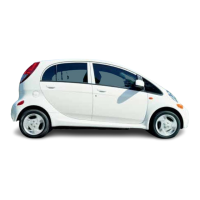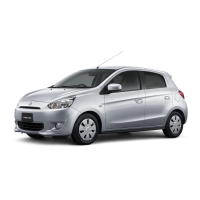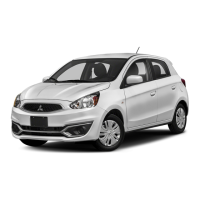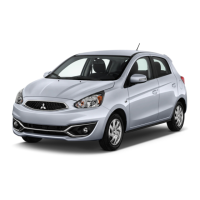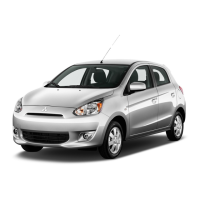.
Chapter 1 Tune-up and routine maintenance
l-9
4.14a The reservoir for the windshield washer fluid is located
on the right side of the engine compartment and fluid is added
after flipping the top up-how often you use the washers will
dictate how often you need to check the reservoir
4.14~ The rear washer fluid reservoir is located in the rear cargo
area, behind a cover
must be periodically replenished. See Recommended lubricants and
fluidsat the beginning of this Chapter before adding fluid to any of the fol-
lowing components. Note: The vehicle must be on/eve/ground when fluid
levels are checked.
Engine oil
Refer to illustrations 4.2, 4.4 and 4.6
2 The engine oil level is checked with adipstick that extends through a
tube and into the oil pan at the bottom of the engine (see illustration).
3 The oil level should be checked.before the vehicle has been driven, or
about 15 minutes after the engine has been shut off. If the oil is checked
immediately after driving the vehicle, some of the oil will remain in the up-
per engine components, resulting in an inaccurate reading on the dipstick.
4 Pull the dipstick from the tube and wipe all the oil from the end with a
clean rag or papertowel. Insert the clean dipstickall the way back into the
tube, then pull it out again. Note the oil at the end of the dipstick. Add oil as
necessaryto keep the level between the MAXand MIN marksorwithin the
hatched area on the dipstick (see illustration).
5 Don’t overfill the engine by adding too much oil since this may result in
oil fouled spark plugs, oil leaks or oil seal failures.
6 Oil is added to the engine after removing a threaded cap from the
valve cover (see illustration). An oil can spout or funnel may help to re-
duce spills.
7 Checking the oil level is an important preventive maintenance step. A
consistently low oil level indicates oil leakage through damaged seals, de-
fective gaskets or past worn rings or valve guides. If the oil looks milky in
color or has water droplets in it, the cylinder head gasket(s) may be blown
or the head(s) or block may be cracked. The engine should be checked
immediately. The condition of the oil should also be checked. Whenever
you check the oil level, slide your thumb and index finger up the dipstick
before wiping off the oil. if you see small dirt or metal particles clinging to
the dipstick, the oil should be changed (Section 13).
4.14b On headlight washer-equipped models, flip up the cap
to add fluid
Engine coolant
Refer to illustration 4.6
Warning: Don’t allow antifreeze to come in contact with your skin or
painted surfaces of the vehicle. Flush contaminated areas immediately
with plenty of water. Don’t store new coolant or leave old coolant lying
around where it’s accessible to children or pets-they’re attracted by its
sweettaste. lngestionofevenasmallamountofcoolantcan be fatal! Wipe
up garage floor and drip pan coolant spills immediately. Keep antifreeze
containers covered and repair leaks in your cooling system immediately.
8 All vehicles covered by this manual are equipped with a pressurized
coolant recovery system. A white plastic coolant reservoir located in the
engine compartment is connected by a hose to the radiator filler neck (see
illustration). If the engine overheats, coolant escapes through avalve in
the radiator cap and travels through the hose into the reservoir. As the en-
ginecools, the coolant is automatically drawn back into the cooling system
to maintain the correct level.
9 The coolant level in the reservoir should be checked regularly. Warn-
ing: Do not remove the radiator cap to check the coolant level when the
engine is warm. The level in the reservoir varies with the temperature of
the engine. When the engine is cold, the coolant level should be at or
slightly above the lower mark on the reservoir. Once the engine has
warmed up, the level should be at or near the upper mark. If it isn’t, allow
the engine to cool, then remove the cap from the reservoirandadd a 50150
mixture of ethylene glycol-based antifreeze and water.
10 Drive the vehicle and recheck the coolant level. If only asmall amount
of coolant is required to bring the system up to the proper level, water can
be used. However, repeated additions of water will dilute the antifreeze
and water solution. In order to maintain the proper ratio of antifreeze and
water, always top up the coolant level with the correct mixture. An empty
plastic milk jug or bleach bottle makes an excellent container for mixing
coolant. Do not use rust inhibitors or additives.
11 If the coolant level drops consistently, there may be a leak in the sys-
tem. Inspect the radiator, hoses, filler cap, drain plugs and water pump
(see Section 9). If no leaks are noted, have the radiator cap pressure
tested by a service station.
12. If you have to remove the radiator cap, wait until the engine has
cooled, then wrap a thick cloth around the cap and turn it to the first stop. If
coolant or steam escapes, let the engine cool down longer, then remove
the cap.
13 Check the condition of the coolant as well. It should be relatively clear.
If it’s brown or rust colored, the system should be drained, flushed and re-
filled. Even if the coolant appears to be normal, the corrosion inhibitors
wear out, so it must be replaced at the specified intervals.
Windshield, headlight and rear washer fluid
Refer to illustrations 4.14a, 4.14b and 4.14~
14 Fluid for the windshield washer system is stored in a plastic reservoir
located on the passenger’s side of the engine compartment (see illustra-
tion). If necessary, referto the underhood component illustration(s) at the
beginning of this Chapter to locate the reservoir. Some models are
equipped with headlight washers. The fluid reservoir is located on the left
side of the engine compartment and should be kept filled the upper mark
(see illustration).
On vehicles with rear window washers, the fluid reser-
voir is located under a cover on the right side of the cargo area (see
illus-
tration).

